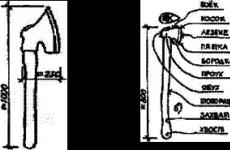Description of the cherry “Robin. Characteristics and cultivation of high-yielding robin cherries Selection and preparation of planting material
Cherry varieties
Vladimirskaya
Felt
Zhukovskaya
Zagoryevskaya
Lyubskaya
Robin
Chocolate girl






Vladimir cherry variety has several names (Roditeleva, Vyaznikovskaya, Izbyletskaya, Gorbatovskaya, Dobroselskaya). A very old variety widespread in Russia. The fruits are large, weighing 3.4 g. They ripen early in mid-July. The skin is black-red, the flesh is dark red, dense, juicy, aromatic. The juice is dark cherry thick. The bone comes off easily. The fruits of the Vladimir cherry are characterized by excellent taste. They are used both fresh and for processing. The variety is winter-hardy and high-yielding. It begins to bear fruit in the 2nd year.
Cherry Felt . Cherry grows as a small bush up to 2m high. In July, the branches are loaded with garlands of bright berries. The fruits are round, densely arranged along the branches, on a short stalk (like sea buckthorn). The berries are tender with thin skin, juicy, and have a pleasant sweet taste. Felt cherry is characterized by frost resistance, early fruiting, and high yield.
Cherry Zhukovskaya . The variety is large-fruited with a fruit weight of 4.3 g. The fruits are oval, dark red, ripen in the second half of July. The pulp is dark red, dense, juicy. The taste is excellent, sweet and sour, pleasant. The stone is easily separated from the pulp. A high-yielding variety, resistant to disease, early fruiting, with simultaneous ripening, the fruits hang on the tree for a long time without falling off. Universal purpose. Pollinators: Vladimirskaya, Lyubskaya.
Cherry Zagoryevskaya . The tree is low-growing, up to three meters high with a ball-shaped crown. The fruits are large, weighing up to 4.3 g, the color of the fruit is dark red. Pulp: medium density, red, juice dark red. Very good dessert taste. Stone: medium, easily separated from the pulp. Ripening period: July 12 - 18. The variety does not require a pollinator and is winter-hardy. Productivity is high, annual.
Cherry Lyubskaya . An ancient Russian variety of folk selection. It grows as a small compact tree 2.5 m. The fruits are very large massai 4.5 g, red, ripen in late June early August and hang for a long time without falling off. The juice is red, sweet and sour (11% sugar). This is the most productive of all Central Russian varieties and does not require a pollinator. Winter-hardy, early fruiting (bears fruit in the second year). It is a good pollinator for other cherry varieties.
Cherry Chocolate Girl . A low-growing tree 2.1 - 2.5 m. Fruits weighing 3.4 g are almost black. The pulp is dark red, medium density, the juice is dark red. The taste is sweet and sour, very good. The bone is easily separated from the pulp. Flowering in the middle period (May 16-18). The fruits are of medium ripening period (July 9-16). The variety is drought-resistant and does not require a pollinator variety. Winter hardiness of both wood and fruit buds is high.
Cherry Malinovka . Tree of average growth 3 - 3.5 m. The crown is round and dense. Fruits weigh above average 3.5 - 4 g, fruit detachment is semi-dry. The pulp is red, dark, dense, juicy. The stone is medium-sized, easily separated from the pulp. The taste of the fruit is sweet and sour. The ripening period is late (June 25-30). The best pollinators are Lyubskaya, Shubinka, Vladimirskaya.
This cherry variety was bred in 1988 by breeders H.K. Enikeev and S.N Satarova in VSTISP.
These breeders, famous among gardeners, have bred more than one variety, which has greatly diversified many gardens.
The region of natural growth of this winter-hardy variety are: Central, Middle Volga and Ural.
Appearance of Malinovka cherry
Let us consider separately the appearance of the tree and the fruit.
Tree
Cherry Malinovka has medium vigor and grows up to 3-3.5 meters in height. The crown of the tree is rounded or spherical, slightly elevated, dense.
Leaves standard size. The colors on the bottom and top of the sheet are slightly different. The leaf is green on top and has a slight gloss and smoothness; on the bottom the leaf is light and ribbed.
Fetus
The fruits are formed mainly on last year's growths. The fruits themselves are a rich dark red berry.
The berries are not large, but above average - about 3-4 grams per berry. The stone inside is medium in size and easily separated from the pulp. The pulp is dense, with dark red juice. The taste is pleasant, slightly sour.
REFERENCE! Most often, the variety is used in industry in processed form. Its fruits produce amazing taste qualities compotes, jellies, jams, preserves or dried fruits.
Photo






Characteristics of the variety
But the yield is very high - 10-14 tons per hectare.
 The plant can withstand the cold well, but the flower buds may freeze a little.
The plant can withstand the cold well, but the flower buds may freeze a little.
There is one drawback: Malinovka variety self-sterile.
This means that another pollinating variety needs to be planted nearby.
Otherwise, the plant will bloom, but will not bear fruit.
Planting and care
Before planting, it is important to choose the right planting site, namely the soil.
It is important to pay attention to the presence of water sources underground. The accumulation of underground water can be detrimental to the root system of the future tree.
Therefore, preference should be given to areas for planting soil without groundwater, or with groundwater at a depth minimum 1.5 meters.
 Before planting, the soil also needs to be prepared. To do this, fertilizers are added to the ground, and only then the bush is planted. Basic care is quite simple.
Before planting, the soil also needs to be prepared. To do this, fertilizers are added to the ground, and only then the bush is planted. Basic care is quite simple.
Necessary periodically trim the tree crown and remove weeds And wild plants around the bush. Important before pruning Water the cherries regularly and fertilize them regularly.
ATTENTION! Only healthy plants that develop in a timely manner should be pruned. If you prune a diseased cherry, this may expose it to complete destruction.
It is advisable to plant Malinovka on southern and southwestern slopes and hills where there is no wind. Cherry Robin needs sunny, well-lit places.
Together with Malinovka It is advisable to plant pollinating varieties nearby.
Diseases and pests
A big advantage of the variety is its average resistance to coccomycosis. No grape variety is highly resistant to this disease, and Malinovka can guarantee complete non-infection with proper care.
 Coccomycosis – fungal disease, affecting the leaves or fruits of cherries. Within a few years of the disease, the cherry completely dies in winter period. The fungus appears on fallen leaves in autumn.
Coccomycosis – fungal disease, affecting the leaves or fruits of cherries. Within a few years of the disease, the cherry completely dies in winter period. The fungus appears on fallen leaves in autumn.
Other diseases are no less dangerous and require care and treatment.
Moniliosis– the disease is also caused by a fungus, but affects the bark of the tree and cherry fruits. Thus, the branches gradually die. Infected parts of the plant should be removed and treated with medications.
Hole spot- a disease that gradually leaves holes in the leaves. Soon after the onset of the disease, deformation of the leaves and drying of the berries occurs. You should again cut out the branches and burn the fallen infected fruits and leaves.
Anthracosis- appears as a pinkish coating on the fruit. In this case, only removing the infected berries and spraying the tree with Polyram three times helps.
Gum treatment– appears as a result of the diseases described above. Gum is released from the branches and trunk, which can subsequently lead to the death of the cherry tree.
To prevent this disease, it is necessary to provide high-quality care for plants in order to protect them from other diseases in the first place.
While diseases can completely destroy your cherries, insects can easily kill your harvest. Therefore, it is important to detect them in time and get rid of them.
 Cherry aphid– draws sap from the entire plant, drying it out.
Cherry aphid– draws sap from the entire plant, drying it out.
To avoid its appearance, you should pull out weeds and other growth around the plant in advance.
Cherry weevil- can completely doom your crop to destruction.
It eats cherry buds and flowers. And at the same time it can leave eggs on the fruits.
To fight it, in the fall it is necessary to loosen the soil around the tree, and in the spring, throw the weevils off the branches and destroy them.
Slimy sawfly– leaves larvae on the leaves, which then destroy the fruits. You can only get rid of it by spraying with preparations after harvesting.
Shoot moth– its caterpillars destroy cherry buds, as well as leaves and buds. To combat moths, spray with preparations during the period of bud formation.
Preparations against pests: Iskra, Inta-Vir, Aktara, Karbofos, etc.
Let's summarize. The Malinovka cherry variety is suitable for growing in warm, sunny regions of our country. Grown mainly for processing into other products.
The variety has its advantages: high yield, late date maturation, frost resistance, high commercial qualities.
 But there are also disadvantages: self-infertility, average resistance to diseases.
But there are also disadvantages: self-infertility, average resistance to diseases.
Caring for a tree does not require much effort; the Malinovka variety is attractive in this regard.
Diseases and pests are the same as for everyone else, and the fight against them is standard, as with other varieties.
If you find an error, please highlight a piece of text and click Ctrl+Enter.
- Gum therapy
- Before planting, the soil also needs to be prepared. To do this, fertilizers are added to the ground, and only then the bush is planted. Basic care is quite simple.
Self-fertile varieties
The stone inside is medium in size and easily separated from the pulp. The pulp is dense, with dark red juice. The taste is pleasant, slightly sour.
- Quite bright and significant flaws for this species fruit tree not found. The main disadvantages of such cherries are as follows:
- Used for making compotes, juices, jams, preserves. Used fresh and frozen.
- Weak resistance to moniliosis, relatively small fruits, self-sterility.
Winter hardiness.
Cherry varieties by ripening time
- Excellent taste - sweet with slight sourness.
- The “Turgenevka” variety was bred by A.F. Kolesnikova, T.S. Zvyagina and G.B. Zhdanova at the Research Institute of Fruit Crop Breeding. Entered into the Register of zoned varieties in 1979 for the Central, Central Black Earth, and North Caucasus regions.
- Disease resistance.
Diseases and pests are the same as for everyone else, and the fight against them is standard, as with other varieties.
Early varieties of cherries
Cherry "Annushka"
- appears as a result of the diseases described above. Gum is released from the branches and trunk, which can subsequently lead to the death of the cherry tree.
NecessaryHELP!
need for annual treatment fungicidal preparations, which will reduce the risk of developing fungal infections; Cherry is one of the most popular fruit-bearing trees in our garden. It can be found in almost any garden. Breeders bred a large number of varieties with the most diverse characteristics. One of them, namely Molodezhnaya cherry, will be discussed in this article. Here we will look at the description of this variety, its characteristics, advantages and disadvantages.
There can be no definite answer. The taste and color... as they say. Yes and in different regions we live. I have seven varieties. Only three have a name (bought): Altai swallow, Rodnichok, Shchedraya. Each is good in its own way. There are always plenty of berries. And there are also 3 small felt bushes. There were big ones, but the neighbor watered the garden with slurry, the slope was in our direction. The roots have burned out. Now I grow it from my own seeds. Changed location. Low. Almost every harsh winter leads to losses in the garden. Cherry trees often freeze their trunks and skeletal branches. At the same time, flower buds are highly resistant to late frosts.
Pleasant cherry aroma. The seeds are small - especially in comparison with the “berry” itself (we remind you that cherry fruits are not berries). The size and shape of the crown.
Resistant to coccomycosis.high-yielding (at least 8…10 kg of berries per tree);
To prevent this disease, you need to provide high-quality care for plants in order to protect them from other diseases in the first place. Prune the tree crown periodically and remove weeds
Most often the variety is used in industry in processed form. Its fruits produce compotes, jellies, jams, preserves or dried fruits that are amazing in taste. Resistance to various infections decreases in humid and warm climates;
Mid-season (medium) cherry varieties
Cherry Molodezhnaya
The Youth Cherry variety was developed by breeders as a result of crossing Vladimir and Lyubskaya cherries. Refers to the type of common cherry (such as the varieties Rusinka, Morozovka, Mayak, etc.) In its characteristics and properties it is similar to the Malinovka variety. Today she has wide use. It can be found in Ukraine, Belarus, Russia.
Chinese - it is medium in size, not sweet and not sour! The first berries will appear between June and July! Resistance to fungal diseases.
The yield is high - about 16 kg per tree. Taking into account its height, this is not surprising.Tree up to 3 meters high. The crown is reverse pyramidal. Inflorescences are four-flowered. Fruits are formed mainly on bouquet branches.
Advantages:
resistant to the most common diseases.If diseases can completely destroy your cherries, then insects can easily kill your harvest. Therefore, it is important to detect them in time and get rid of them.
and wild plants around the bush. Important before pruning Cherry variety Malinovka has
necessity correct selection planting site, on which the growth of the seedling directly depends. Poorly ventilated and flat areas are not suitable for it; This type of cherry can be represented by either a tree or a bush. The appearance of the tree is shown in the photo below.
For me, Vladimirovka. Almost zero. Trees are often affected by both coccomycosis and moniliosis.
Self-fertility.
Cherry Turgenevka
Fruits and productivity.
early ripening, winter hardiness, high yield, delicious berries, resistance to coccomycosis.Typically, stone fruits produce fruit through cross-pollination, when pollen is transferred from one tree to another (preferably different varieties) with the help of insects. At the same time, a small number of berries can also be formed when pollinated by one’s own pollen. The ability to form fruits with such pollination is called self-fertility. In horticulture, the following classification of varieties according to self-fertility is accepted:
Cherry aphid Regularly water the cherries and fertilize them in time.
Annual feeding of the tree with phosphorus, nitrogen, and potassium is necessary. If there is a lack of these elements in the soil, the yield is significantly reduced; The maximum height to which a tree or bush can grow is 2.5 meters. The crown of this variety is slightly drooping and rounded. The leaves of the Youth Cherry are medium in size and bright green in color. For drawing leaf blade characterized by crenate edges.
I'm looking for reviews myself. I just ordered some seedlings felt cherry(there are also many varieties of them) - I decided at random which one they would bring. And among the ordinary ones, I read something good about Kharitonovskaya (it seems so). Advantages:
The variety is self-sterile; it is recommended to plant it with the Kentskaya, Lada and Chernaya large varieties. Ripening occurs in mid-July. The fruits are large, wide-heart-shaped, weighing more than 5 grams. The color is dark red. The pulp and juice are also dark red, the taste is unfortunately average. But Turgenevka cherries have a relatively small pit. The stalk is long and does not come off very well.
Disadvantages:self-fertile - forming berries on 20...40% of flowers;
- draws sap from the entire plant, drying it out.ATTENTION!
Cherry Nadezhda
tendency to severe overgrowth.This cherry tree begins to bear fruit on growth from the previous year, as well as bouquet branches.
I also planted felt without knowing the variety.The relatively low crown simplifies the creation and maintenance of industrial gardens, good yield potential. Winter hardiness.The yield of the variety is within 10..12 kg per tree, from the very tall trees more.
lack of resistance to moniliosis.
partially self-fertile - forming berries on 10...20% of flowers; To avoid its appearance, you should pull out weeds and other growth around the plant in advance.
Only healthy plants that develop in a timely manner should be pruned. If you trim a diseased cherry, this may expose it to complete destruction. But
However, the advantages of this cherry outweigh its disadvantages.The youth variety is characterized by early fruiting. It begins to bear fruit at the age of four. The berries ripen in mid-July. Its fruits can reach a mass of 4.5 g. They are oval in shape, up to a centimeter in diameter (photo below). The Molodezhny variety bears sweetish-sour fruits. The fruits have dense pulp that is very juicy. Cherry juice is dark red in color. The stone is medium in size and quite easily separated from the pulp. The youth variety, according to the tasting characteristics of its fruits, belongs to the dessert variety. Its fruits are used both for fresh food and for all types of preservation. Compotes, preserves, jams and marmalade are made from the berries.
Malinovka and Molodezhnaya are not tall and very sweet - I have these. I'm happy!Disadvantages:
Good winter hardiness of trees, slightly worse - of generative buds.Self-fertility.
Late-ripening (late) cherry varieties
Cherry Lyubskaya
Youth is one of the most frost-resistant varieties cherries, it is ideal for growing in the conditions of the Moscow region and Middle zone at all. The variety was bred in VSTISP Kh.D. Enikeev and S.N. Satarova from crossing the Lyubskaya and Vladimirskaya varieties. Included in the Register of Zoned Varieties for the Central Region.
Self-sterile - approximately 5...10% of flowers form berries. For such varieties, cross-pollination is necessary. Cherry weevil
It is advisable to plant Malinovka on southern and southwestern slopesThe yield is very high - 10-14 tons per hectare.
In order for your tree to bear fruit well and the quality of the harvest to be excellent, you need to properly plant, grow and care for it.
Up to 12 kg of crop can be harvested from one bush or tree during the fruiting period.
One of the best varieties in terms of berry size, yield, and taste is considered to be the LYUBSKAYA variety. It is also a good pollinator for other varieties. Another productive and tasty ancient variety SPANKA. low winter hardiness and resistance to fungal attack, mediocre taste of fresh berries
Disease resistance.The variety is partially self-fertile; it is highly recommended to plant it next to other varieties of cherries or sweet cherries.
Dimensions and shape of the crown.Choosing self-fertile varieties cherries, you will be less dependent on the activity of bees, bumblebees and other pollinating insects, as well as on the availability and flowering time of other varieties of cherries. This will make your harvests more stable.
- can completely doom your crop to destruction.and hills where there is no wind. The Cherry Robin needs sunny, well-lit places.
The plant can withstand the cold well, but the flower buds may freeze a little. The optimal time for planting young cherries is spring. This tree should be planted on hills and in well-lit areas of the garden, where people pass nearby. groundwater, and the soil is slightly alkaline or neutral. Planting is carried out in a hole with parameters of 40x80 cm (depth, diameter), into which organic fertilizers are added before planting.
Cherry Malinovka
This type of youth cherry belongs to the group with average winter hardiness. The stability of flower buds is also average. According to the description, it is similar to the Vladimirsky variety. This cherry has average resistance to damage various diseases(coccomycosis and moniliosis) and microorganisms. The tree gets sick especially often during humid and warm summers.
" The Cherry Orchard"Remember Chekhov. On his estate, the cherry variety "Shubinka" is so sour and small, but the best variety no for jam with seeds. Very productive, but one will not produce fruit. The Malinovka variety was bred in VSTISP Kh.D. Enikeev and S.N. Satarova. Entered into the Register in 1988 for the Central, Middle Volga and Ural regions. It is a typically late-ripening variety (ripens from July 25 to August 5).
Good resistance to both moniliosis and coccomycosisWinter hardiness.
Can form a tree or bush up to 2.5 meters high. The crown is rounded, slightly drooping.early - early-mid July;
It eats cherry buds and flowers. And at the same time it can leave eggs on the fruits.Together with Malinovka
There is one drawback:After planting, fertilize every spring nitrogen fertilizers, the amount of which depends on the age of the tree. And in the fall, fertilizing is carried out with potassium and phosphorus fertilizers. For better growth Manure or compost is also added to the soil.
Dignity of this type cherry is that it is one of the most reliable varieties in terms of yield, which are presented in nurseries of all major cities (Moscow, Kyiv, Minsk, etc.). Molodezhnaya is a delicious cherry. Vladimirskaya has now almost degenerated (the real Vladimirka!). And she is very susceptible to moniliosis. Several years ago, all the cherries in our entire district died (just in the Vladimir region). Just for fun, I ordered the Udarnitsa variety from Chelyabinsk. Good! Large, tasty, compact low bush, 2 meters tall. I also want to order several varieties from Chelyabinsk. This year, the offspring of the dead Vladimir women bore fruit well; the harvest was collected in a race with wasps to see who was the fastest. Good, tasty berries. I also planted felt, it often dies out in the area of the root collar. Refused her.
Dimensions and shape of the crown.Advantages:
The Malinovka cherry, bred by Russian scientists for the Central region, the Volga region and the Urals, has successfully taken root in industrial and amateur gardens. It is distinguished by sufficient hardiness for the growing regions and good taste. Just like any other representative fruit crop, the variety has its own characteristics that gardeners should learn about.
History of the Malinovka variety
Cherry appeared at the All-Russian Breeding and Technological Institute of Horticulture and Nursery Science (VSTISP) thanks to breeders Kh. K. Enikeev and S. N. Satarova. The sources do not mention parent varieties.
Since 1978, Malinovka has been under state variety testing. In 1989, the variety was included in the State Register for the Central, Middle Volga and Ural regions, where it became widespread.
Description and characteristics of Malinovka cherry
The tree grows to a moderate height (3–3.5 m). The crown has the shape of a ball and is prone to thickening. Leaves with crenate edges, medium size, glossy.

The Malinovka cherry tree is medium-sized, with a spherical dense crown
Flowering occurs on last year's growths. Based on this characteristic, the variety can be classified as a bush type.
Cherry varieties are divided into tree-like and bush-like. This division does not depend on appearance tree, but on the nature of fruiting. Tree cherry can have a multi-stemmed form similar to a bush, and bush cherry can grow in a standard form. The main difference between the types of plants is that in tree cherry, flower buds are formed mainly on bouquet branches, and in bush cherry - on annual growths.
The fruits are above average size (3.5–4 g), round in shape. The color of the skin is dark red. The short and thin stalk has a semi-dry tear.

The fruits of the Malinovka cherry are above average size, dark red in color
The pulp is dense, tender and juicy. The color of the pulp and juice is dark red. The taste is good, sweet and sour. The stone is medium-sized, separated from the pulp freely. The purpose of the variety is technical; the berries are used mainly for processing: canned products are of high quality.

Malinovka cherry fruits are ideal for processing
The harvest ripens in the mid-late period, at the end of July. VNIISPK (All-Russian Research Institute for Breeding Fruit and Fruit Plants) berry crops) characterizes the variety as early-bearing; the State Register notes low early fruiting. The yield is abundant, 10–14 t/ha. The sources do not mention productivity from one tree. The ability to self-pollinate is absent.
The State Register indicates high winter hardiness of wood and flower buds, while the VNIISPK variety catalog indicates above average. Immunity to coccomycosis is average, to moniliosis - low. There is no information in the sources about resistance to drought and pest damage.
The advantages of the variety include the following properties:
- late ripening;
- productivity;
- good taste of fruits;
- low tree;
- winter hardiness;
- excellent quality canned products.
Few shortcomings were identified:
- self-sterility;
- insufficient resistance to some fungal diseases.
How is the variety pollinated?
When planting trees, you must immediately take care of cross-pollination of self-sterile plants. Experts say that the pollination work of bees is effective at a distance of up to 40–50 meters. Perhaps they are already growing in the immediate environment cherry trees, blooming at similar times. But the closer the source of pollen is, the more flowers will be fertilized. The most in a reliable way To increase the productivity of Malinovka, planting pollinator trees next to it will be possible: Vladimirskaya, Lyubskaya and Shubinka cherries are considered the best for this purpose.

The Malinovka cherry variety is self-sterile; pollinating trees should grow next to it
Features of growing Malinovka cherries
The described variety is quite unpretentious, therefore, when cultivating it in general, agricultural techniques usual for the crop are used. Considering some varietal characteristics cherries, plant productivity will increase.
Landing
In the regions where the variety grows, trees are planted in the spring; seedlings planted in the fall may not have time to take root and freeze out. The basic growing conditions are usual for cherries. The landing process also has no special features. The layout of the trees is 3x4 m; you should not plant them thicker, so as not to provoke the development of fungal diseases.
Tree care
There is no information about the drought resistance of the variety, therefore better plants Water according to a standard schedule. In a season with normal precipitation, trees are watered before flowering, twice after it and a month before the onset of frost. Plants are fed according to the usual scheme, without any special features: in the spring the trees need nitrogen, in the summer potassium and phosphorus, in the fall superphosphate is added when digging.
For the Malinovka, a tieless crown formation, often used for cherry trees, is best suited. On the central conductor at a height of 30–40 cm, single branches begin to be laid at a distance of about 15 cm from each other. The main condition for such formation is that the skeletal branches must be directed towards different sides, otherwise they will intertwine. Over 3–4 seasons, up to 10 frame branches are formed.

Tierless crown formation is often used for cherry trees
Since the crown is prone to thickening, and the variety is not resistant to all fungal diseases, sanitary pruning and thinning are required. When pruning for fruiting (shortening), you need to remember that bush-type cherries have the strongest growth bud at the top of the shoot. Sometimes it is the only one, so when shortened, the branch may dry out. It is better not to take risks and cut the shoots only to the side branch, in which the apical bud will definitely grow.
Video: pruning cherries for harvest
Damages dangerous to the variety
The most likely diseases are coccomycosis and moniliosis; the variety has insufficient immunity to them. In order to take timely measures, you should have an understanding of the diseases. They have the following characteristics:

To prevent the spread of diseases, standard preventive measures are carried out: sanitary work, as well as autumn and early spring treatments with 3% Bordeaux mixture. If prevention turns out to be ineffective, after flowering 2-3 times with a two-week interval, they are treated with fungicides Horus, Abiga-Pik, Skor and others.
From attack possible pests plants will be protected by the same preventive measures as against diseases. But when carrying out preventative treatments chemicals you will need to add insecticides to them.
×
My Family Garden - Help
Dear friends!
It’s very easy to get lost in such a large assortment of all kinds of products, and of course you want so many things! But it happens that it is not possible to order everything at once.
So that you don’t lose the products you like and don’t waste time searching for them, we have created a convenient section for you where you can save the items you like.
Now you can create your own “Family Garden”.
On the page of our new section you have the opportunity to create convenient lists for you where your plans for future plantings will be stored.
Sort products into lists by price, culture, planting time, or any property convenient for you.
Did you like something but want to order it later?
Create a list, save the selected items there and, when the time comes, click the “all items to cart” button. On the right bottom corner The total amount of the future order will be shown.
To get started, use the already created “Favorites” list and save all the items you like to it. If you want to create a list with your own name, just click the “Add new list” button. Give it any name that will help you navigate, for example, “Seeds for 2016”, “My Club”, “Summer Flowerbed”, etc. And when the time comes, in a few clicks order all the necessary goods, for example, for your winter garden.
Browsing now detailed description product, you can click the “Add to My Family Garden” button, and the product you like will be saved in the folder of your choice.
Easy, fast, convenient! Happy shopping!
How to use the My Family Garden section
To add a product to My Family Garden, you must go to the product page.
In the appeared additional window You must select the list to which you would like to add the current product. You can select New List by giving it a name. After selecting the list, you must click on the “Ok” link.

My Family Garden
On the section page you can view all the products you have added, as well as the lists you have created.

From here you can add items to your cart individually:

And also the whole list:

You can also remove a product from the selected list:

Or clear the entire list of products:

To completely delete the list, use the following link:

Create lists on various topics. Examples of names can be very different: “My future summer flowerbed”, “For the dacha”, “Apple orchard” and many others. Do you know exactly what fruit and berry seedlings you will order? So call the list “Delicious”, adding your favorite varieties there. And when the time comes, order the entire list in just a few steps.
We have done everything to make My Family Garden as convenient and easy to use as possible!






